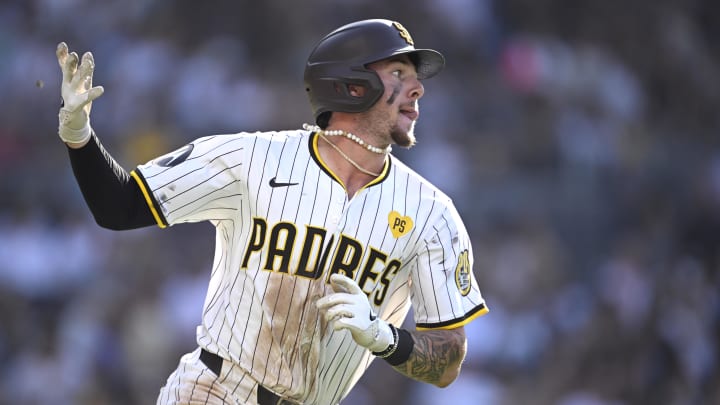National League Rookie Roundup: Five Hitters Catching Fire

Welcome to the Rookie Roundup, a weekly look-in on baseball’s best and most interesting first-year players. Last week, we examined how five American League rookies have recovered from slow starts to their seasons. Next up, we’ll highlight how this group of National League hitters have started to catch fire at the plate.
By week’s end, every team will have played at least 81 games. The All-Star break—traditionally (and erroneously) viewed as the halfway mark of the schedule—is still a few weeks off, but the standings tell no lies: the first half of the season is nearly in the rearview mirror.
To this point, the National League rookie conversation has been mostly dominated by pitchers. Paul Skenes, Yoshinobu Yamamoto, Shōta Imanaga, Jared Jones and Gavin Stone have all put up huge campaigns. But their stellar play has overshadowed some strong showings by NL rookie hitters.
So that’s who we’ll be focusing on this week. All five of the hitters featured here play for teams that are firmly in the playoff hunt (which is a descriptor that could apply to nearly the entirety of the mediocre NL, but still). Whether any of the five can maintain their pace and join the thick of the NL Rookie of the Year remains to be seen. But with summer officially here, these bats have heated up.
Jackson Merrill, CF, San Diego Padres
Merrill’s approach at the plate is wildly impressive considering his age (21) and the fact that this season marks his first taste of big league pitching following a mere 200 minor league games. A first-round pick in 2021, Merrill came up as a shortstop but moved to center field this season in deference to Gold Glove winner Ha-Seong Kim. The transition has been seamless, with Merrill demonstrating plenty of athleticism and instincts to be a plus defender right out of the gates.
Offensively, though, is where the 6’3”, 195-pound Merrill has begun to thrive. An up-and-down first two months saw Merrill make lots of contact with very little power—a fine hitting profile given his speed and defensive contributions, but not the stuff of a superstar in the making. In 56 games through the end of May, Merrill had a .360 slugging percentage with just eight extra-base hits. Since the start of June, he’s slashing .312/.346/.649 with seven homers. Merrill’s aggressive approach at the dish—he swings at 38.8% of pitches he sees outside the zone, the 17th-highest among qualified hitters—remarkably doesn’t produce a ton of strikeouts, nor does it diminish the quality of his contact. His 16% strikeout rate is well below league average (22.2%), and his expected slugging percentage (.500) is in the 95th percentile of all hitters, per Statcast. That combination of skills makes his offensive floor quite high. The athleticism and fact that he’s just 21 make his ceiling, as Air Jordan would say, the roof.
Michael Busch, 1B, Chicago Cubs
Busch hit the ground running to start the season, quickly endearing himself to Cubs fans after being traded to Chicago from the Los Angeles Dodgers. He hit six homers with an .833 OPS through the end of April, though he batted just .208 in May with a 37.2% strikeout rate.
The 26-year-old has rebounded in June, posting a .327/.421/.490 slash line while cutting the K-rate down to a more manageable 24.6%. For a guy with a 32.3% strikeout rate on the season, Busch surprisingly doesn’t chase much, swinging at pitches outside the zone only 25% of the time (league average is 31.5%). His 32.1% whiff rate indicates some glaring holes in his swing, but he’s able to take advantage of mistakes enough to make up for his deficiencies. If he can keep doing damage on pitches that drift into his sweet spots, then Busch has a real chance to keep moonlighting as Kyle Schwarber Lite.
Masyn Winn, SS, St. Louis Cardinals
The athletic Winn teased some power with 18 home runs in 105 Triple A games last year, earning a brief call-up toward the end of the season. That type of output hasn’t arrived in full quite yet, but the 22-year-old is starting to look much more comfortable at the plate.
Through his first 35 games this season, Winn hit .267/.331/.352 with no homers and seven extra-base hits. In 34 games since, he’s put up a .324/.352/.500 slash line, homering four times with 10 doubles and a triple. Drafted as a two-way player, Winn’s pitching days are over, but he’s looking like a foundational piece at shortstop for the Cardinals, particularly if his freshly tapped-into power is here to stay.
Jackson Chourio, RF, Milwaukee Brewers
After signing an $82 million contract months before his MLB debut, Chourio looked overmatched against opposing pitchers. He hit .210 through the end of May with a 27% strikeout rate. It’s a small sample size, but he appears to have gotten settled in during the month of June. In 18 games this month, Chourio is hitting .294/.351/.471, beginning to show off the skill set that made him one of the game’s top prospects. He turned 20 in March and is already an impact defender and baserunner, so as soon as the bat catches up, that contract will start to look like a bargain.
Jacob Young, CF, Washington Nationals
Young received a call-up on April 4 after incumbent center fielder Victor Robles went on the injured list. What could have been a brief fill-in has turned into a supplanting: Young’s bat has performed well enough to keep his elite speed and defense in the lineup in an everyday role, to the point that the Nats released Robles on June 1.
Young posted a .719 OPS in the minor leagues, but got on base often enough to steal 105 bases in 256 games. He’s hit .284/.322/.349 over his past 34 games—not exactly a slash line to write home about, but when you lead the league in Statcast’s fielding run value and make plays like this on a regular basis, that’s more than enough production to stick around for the long term.
